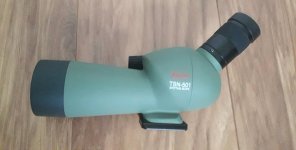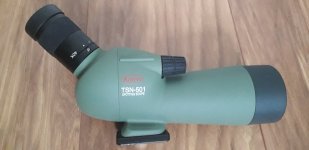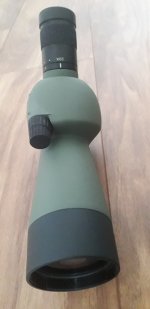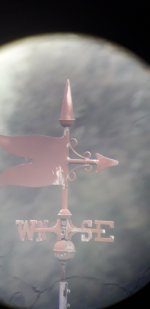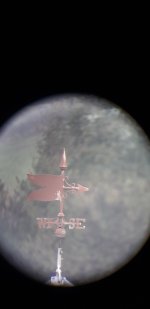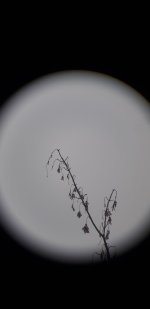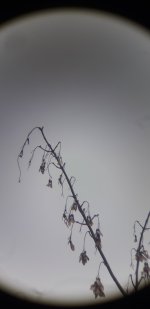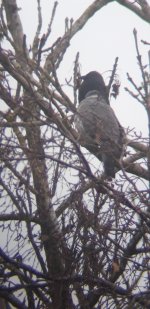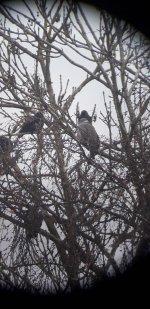dwatsonbirder
Well-known member
Disclaimer: I should preface the following by stating that I am likely planning on selling the scope for reasons which will be covered in detail in the review - I don't want to be accused of drumming up a sale, but hope that this review may assist others who are looking at options for a compact scope.
Introduction
Having previously owned several Nikon ED50 scopes, I decided to abandon the travelscope format on updating/upgrading from the tried and tested Nikon fieldscope series to an 80mm HD Swarovski scope. Earlier in the year I obtained an old Opticron MM2 ED travelscope which proved suitable enough during a trip to the Philippines, though the draw design and lack of waterproofing were concerns in such a humid and occasionally very wet environment.
Fast forward to the present, and I found a good deal on an ex-demo Kowa TSN-501. The scope ticked a lot of boxes (waterproof, compact, very lightweight) however there appear to be limited reviews of the scope in the field available.
Body
Kowa updated the 500 series in March 2017 following on from the previous TS-501/502/504. Like its predecessor, the TSN-501 is a compact, non-ED (the TS-504 had ED glass) travelscope with a fixed eyepiece. The key differences appear to be that the newer model is only available with a zoom (the TS 500 was offered with either a 20x fixed or a zoom), fully multi-coated optics, and a different body shape. The original model retailed at +/- £120 with the fixed lens and +/- £150 with the zoom, where as the RRP on the new model is £319 - a fairly significant increase in price, even considering the increase in inflation.
The scope itself is either a reinforced composite or plastic body, with a metal eyepiece. The focus knob, eyecup and zoom grip have a pleasant soft rubber covering. Interestingly, the body of the scope has a pleasant grippy and slightly coarse texture - one could be forgiven for expecting a smooth textured finish from stock photographs. There is a peep line along the right-hand side of the body, and interestingly the focus knob is also oriented on the right. There is a standard tripod mount with reinforced 1/4" insert on the mounting base.
Despite the slightly quirky appearance, I like the aesthetics of the design, and although it feels tiny, there is a solidity and feel of decent build quality without any heft.
The weight with eyepiece comes in at 412g on my scale - half of that of my Zeiss 7x42 binoculars!
Mechanical operation
Build quality follows through into the mechanical aspects of the scope.
The focus wheel is just roughly one and a quarter fingers width, and turns remarkably smoothly with just the right amount of resistance for my tastes (fairly low). The positioning of the wheel on the right feels a bit odd after years of using helical wheels, and my preference would probably have been for this to be central rather than off to one side - again down to personal choice.
The zoom mechanism has a higher level of resistance though is still easy to turn, with the rubber grip providing some assistance in wet weather or with gloves. Once the desired magnification is set, it is unlikely that it could accidently be knocked out of position or subject to drift.
The eyecup is of the twist out variety, with a single intermediary position - this does not click, and could therefore theoretically be moved if careless - applying some gentle downward pressure, I was quite easily able to depress the eyecup to the fully retracted position. As this is very much a budget scope, the expectation that some areas will suffer as a result of costs is inevitable, however, that the only mechanical issue relates to the eyecup is praise indeed on such an instrument.
The one area which requires some consideration and for me is a deal-breaker with this scope is the eye-relief which varies between 12.5 -14mm across the zoom range. I would advise to try before purchasing if you wear glasses, as for me there was some difficulty in getting the right position with glasses, and comparing the view with and without glasses I was surprised to lose about 25% of the field of view.
There is no extendable hood on the front end of the scope, though the objective lens is recessed about 1.5cm. There is a partial thread on the inside edge which could potentially support a third party screw in hood if needed - I did not test this.
Optics
To keep this brief, I'll summarise these broadly into pros and cons. I will post some images showing IQ across the zoom range later.
Pros
Cons
The Kowa TSN-501 is a great low budget option for anyone looking for a travelscope, first scope, or back-up which could be left in a bag/car/window. The combination of solid build quality, and a good image (considering the small objective lens and standard glass) make this a worthy consideration when space and weight are at a premium.
The primary concerns relate to the short eye-relief and narrow field of view which won't work for everyone - most likely not an issue if you do not wear glasses, but worth checking beforehand if you do.
I would suggest the the TSN-501 is a worthy update of the previous TS-500 series, and optically the equal of the ED version of the Opticron MM2 fieldscope, even with standard glass.
The scope doesn't perform optically at the same level as the Nikon ED50 or newer Opticron MM3 or MM4 ED scopes, however the additional cost of all these, along with the scarcity of obtaining eyepieces for the Nikon, and the added weight of the Opticron scopes mean that Kowa have filled a niche in the market, and provided what is probably the best value travelscope currently available.
Introduction
Having previously owned several Nikon ED50 scopes, I decided to abandon the travelscope format on updating/upgrading from the tried and tested Nikon fieldscope series to an 80mm HD Swarovski scope. Earlier in the year I obtained an old Opticron MM2 ED travelscope which proved suitable enough during a trip to the Philippines, though the draw design and lack of waterproofing were concerns in such a humid and occasionally very wet environment.
Fast forward to the present, and I found a good deal on an ex-demo Kowa TSN-501. The scope ticked a lot of boxes (waterproof, compact, very lightweight) however there appear to be limited reviews of the scope in the field available.
Body
Kowa updated the 500 series in March 2017 following on from the previous TS-501/502/504. Like its predecessor, the TSN-501 is a compact, non-ED (the TS-504 had ED glass) travelscope with a fixed eyepiece. The key differences appear to be that the newer model is only available with a zoom (the TS 500 was offered with either a 20x fixed or a zoom), fully multi-coated optics, and a different body shape. The original model retailed at +/- £120 with the fixed lens and +/- £150 with the zoom, where as the RRP on the new model is £319 - a fairly significant increase in price, even considering the increase in inflation.
The scope itself is either a reinforced composite or plastic body, with a metal eyepiece. The focus knob, eyecup and zoom grip have a pleasant soft rubber covering. Interestingly, the body of the scope has a pleasant grippy and slightly coarse texture - one could be forgiven for expecting a smooth textured finish from stock photographs. There is a peep line along the right-hand side of the body, and interestingly the focus knob is also oriented on the right. There is a standard tripod mount with reinforced 1/4" insert on the mounting base.
Despite the slightly quirky appearance, I like the aesthetics of the design, and although it feels tiny, there is a solidity and feel of decent build quality without any heft.
The weight with eyepiece comes in at 412g on my scale - half of that of my Zeiss 7x42 binoculars!
Mechanical operation
Build quality follows through into the mechanical aspects of the scope.
The focus wheel is just roughly one and a quarter fingers width, and turns remarkably smoothly with just the right amount of resistance for my tastes (fairly low). The positioning of the wheel on the right feels a bit odd after years of using helical wheels, and my preference would probably have been for this to be central rather than off to one side - again down to personal choice.
The zoom mechanism has a higher level of resistance though is still easy to turn, with the rubber grip providing some assistance in wet weather or with gloves. Once the desired magnification is set, it is unlikely that it could accidently be knocked out of position or subject to drift.
The eyecup is of the twist out variety, with a single intermediary position - this does not click, and could therefore theoretically be moved if careless - applying some gentle downward pressure, I was quite easily able to depress the eyecup to the fully retracted position. As this is very much a budget scope, the expectation that some areas will suffer as a result of costs is inevitable, however, that the only mechanical issue relates to the eyecup is praise indeed on such an instrument.
The one area which requires some consideration and for me is a deal-breaker with this scope is the eye-relief which varies between 12.5 -14mm across the zoom range. I would advise to try before purchasing if you wear glasses, as for me there was some difficulty in getting the right position with glasses, and comparing the view with and without glasses I was surprised to lose about 25% of the field of view.
There is no extendable hood on the front end of the scope, though the objective lens is recessed about 1.5cm. There is a partial thread on the inside edge which could potentially support a third party screw in hood if needed - I did not test this.
Optics
To keep this brief, I'll summarise these broadly into pros and cons. I will post some images showing IQ across the zoom range later.
Pros
- Very sharp image, with genuinely impressive resolving detail. Viewing a flock of winter thrushes at a distance of 160m I was clearly able to distinguish the flank streaking and extent and shape of the supercilium on a Redwing. At around 800m it was quite easy to age and follow individual Common Gull feeding in a field at 20x. Increasing the zoom, the image is still excellent at 30x, and even at 40x a good level of detail is evident, though there is a negligible softening on fine detail.
- Colour rendering seems natural, with whites appearing white, and no obvious colour cast.
- Excellent focus "snap". This is most likely as a result of the image sharpness, but impressive to get this with a standard glass optic.
- Colour fringing (CA) isn't too bothersome, and is almost absent in the centre of the field of view at all magnifications - really impressive for standard glass. It doesn't really appear in the view at 20x, kicking in at around 25x though only to a minor degree.
- Quite a bright view given the 50mm objective up to 25x.
- Excellent close focus - perfect sharpness at 2m.
Cons
- Eye relief is short, check if you wear glasses.
- Field of view is quite narrow across the entire field, though the flipside of this is that the sharpness and other aspects are better corrected as a result.
- Colour fringing is apparent in certain circumstances (e.g. viewing bare branches against the sky, dark bird against pale background), becoming more obvious at magnifications of 30x and above.
- Some softness of the image in the outer 25% of the field
- Drop off in brightness at magnifications above 30x.
The Kowa TSN-501 is a great low budget option for anyone looking for a travelscope, first scope, or back-up which could be left in a bag/car/window. The combination of solid build quality, and a good image (considering the small objective lens and standard glass) make this a worthy consideration when space and weight are at a premium.
The primary concerns relate to the short eye-relief and narrow field of view which won't work for everyone - most likely not an issue if you do not wear glasses, but worth checking beforehand if you do.
I would suggest the the TSN-501 is a worthy update of the previous TS-500 series, and optically the equal of the ED version of the Opticron MM2 fieldscope, even with standard glass.
The scope doesn't perform optically at the same level as the Nikon ED50 or newer Opticron MM3 or MM4 ED scopes, however the additional cost of all these, along with the scarcity of obtaining eyepieces for the Nikon, and the added weight of the Opticron scopes mean that Kowa have filled a niche in the market, and provided what is probably the best value travelscope currently available.




